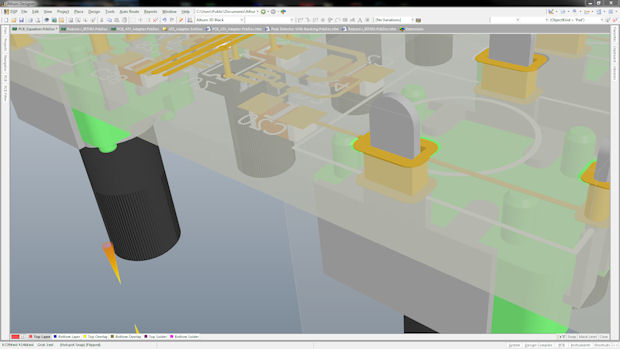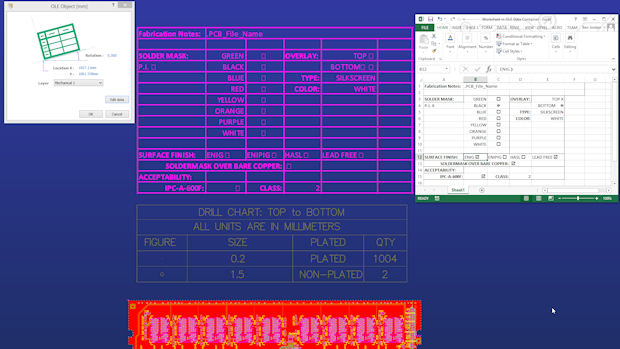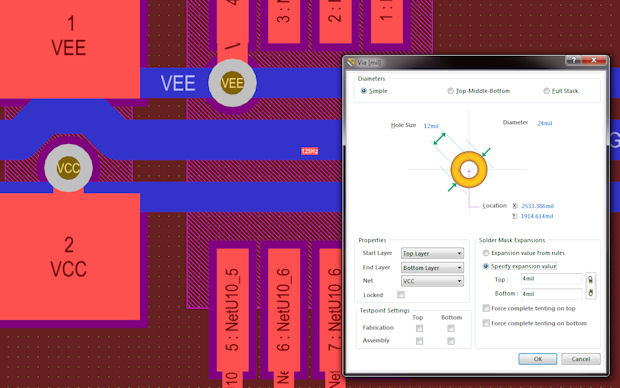January 28, 2015
Altium Ltd., a provider of embedded software development toolkits and PCB (printed circuit board) design systems, released version 15 of its Altium Designer electronics design software. The new release includes enhancements for designing next-generation high-speed PCBs and support for new fabrication output standards, according to the company. In a related announcement, Altium Ltd. also announced that it has extended the benefits available to customers holding an Altium maintenance subscription.
 Altium Designer 15 has been enhanced with support for rectangular pad holes. Image courtesy of Altium Ltd.
Altium Designer 15 has been enhanced with support for rectangular pad holes. Image courtesy of Altium Ltd.In version 15, Altium Designer introduces a new Pin Pairs feature for high-speed signal pin pairs, new support for Ucamco’s Gerber X2 CAD-to-CAM data transfer standard as well as support for the new IPC-2581 vendor-neutral format for PCB design data transfer developed by the International Printed Circuit Association.
The addition of the Pin Pairs feature addresses the challenges earlier generations of software have with designs requiring signal propagation at rates up to 100 GB/s. Typically, the traditional process required manual rework and signal planning outside of the design tool, such as with a spreadsheet program, This, says Altium, exposed designers to numerous, time-consuming extra steps and many opportunities for human error.
The Pin Pairs feature provides users accurate length and phase tuning across termination components as well as length, phase and delay tuning for entire signal paths. Altium says that this feature eliminates the need for external applications as well as the need to maintain complex lists of signals and nets. Users instead will be able to plan and route groups of high-speed nets with much greater efficiency and accuracy, according to Altium.
 New OLE object support in PCB documents in Altium Designer 15 lets users place Microsoft Excel spreadsheets and Word documents directly into their PCB design. Live linking to the original file is supported. Image courtesy of Altium Ltd.
New OLE object support in PCB documents in Altium Designer 15 lets users place Microsoft Excel spreadsheets and Word documents directly into their PCB design. Live linking to the original file is supported. Image courtesy of Altium Ltd.The added support for the IPC-2581 and the Gerber X2 standards helps resolves issues of ambiguous or missing data with older formats. The users can keep up to date and have choices that broaden their selection of PCB fabrication partners. Both specifications describe a PCB according to its design. Data description include such characteristics as copper layer images; plated and unplated holes, slots, routes, grooves and microvias; PCB design outline and cutout regions; complex layer stack regions; and rigid and flexible board areas. Material specifications as well as fabrication notes, tolerances and other critical standards-compliance information are also now communicated with these standards.
“Altium’s R&D engagement with customers is reflected in this software release. We’re very happy with the clear feedback and technical advice about high-speed PCB design offered by our dedicated beta users over the last 12 months,” says Jason Hingston, CTO, Altium, in a press statement. “The PCB industry has also made it clear that fabricators need to move beyond 30+ year old file formats for design to fab[rication] hand-off. With IPC-2581 and Gerber X2 support Altium Designer is ready for users who work with leading-edge fabricators who build complex PCB structures.”
Also new in Altium Designer 15 is support for PCB xSignals, OLE objects in PCB documents and rectangular pad holes. PCB xSignals features, says the company, make “it really easy to define and constrain parallel, T-junction and fly-by net topologies.” The PCB xSignals support, says Altium, is intended to make DDR3/4 memory routing and delay as well as phase tuning of bus signals easier by enabling the correct treatment of a high-speed signal path. That is, it enables a path for the signal to travel between a source and destination, through termination components as well as y-splits.
 For solder mask expansion, Altium Designer 15 enables users to specify different values on the top and bottom layers of pads and vias. Image courtesy of Altium Ltd.
For solder mask expansion, Altium Designer 15 enables users to specify different values on the top and bottom layers of pads and vias. Image courtesy of Altium Ltd.With OLE object support in PCB documents, users can now place Microsoft Excel spreadsheets and Word documents directly into a PCB design, with live linking to the original file. The new support for rectangular pad holes is useful for the placement of snap-in and other specialized components, says the company.
Solder mask expansion and design variant capabilities have also been improved in Altium Designer 15. For solder mask expansion of pads and vias, users can specify different values on the top and bottom layers. Design variants are intelligently supported in Altium Designer, which, says the company, eliminates human errors. Design Rules and BOMs (bill of materials) automatically support alternate component choices.
Altium says that its new Altium subscription model provides customers with the flexibility to choose the best timing for their organization to migrate to a new release without concerns about working with unsupported software. The company adds that this change was requested by users from organizations both large and small.
Now the new subscription model puts earlier versions of Altium Designer on a three-year moving window of maintenance support. Beginning with the release of Altium Designer 15, Altium will deliver product updates and maintenance updates to the current release as well as maintenance updates to previous releases.
 Design variants are intelligently supported in Altium Designer 15, and design rules and BOMs (bill of materials) automatically support alternate component choices. Image courtesy of Altium Ltd.
Design variants are intelligently supported in Altium Designer 15, and design rules and BOMs (bill of materials) automatically support alternate component choices. Image courtesy of Altium Ltd.What this means to users is that, starting with the previous release of Altium Designer, version 14, Altium will deliver fixes and small enhancements as maintenance updates to two preceding releases in addition to updates and upgrades to the current release. Altium subscription customers will continue to receive maintenance updates for Altium Designer version 14 and 15 through the release of Altium Designer version 16 sometime in the future. When version 16 is released, the three-year moving window of maintenance support will be in place. More information on the Altium subscription model is link below.
In total, Altium Designer 15 introduces more than 20 new features and sees over 120 fixes and enhancements across the software as a whole, according to the company blog. Among these are support for generating files using Unicode, improvements and changes to polygon pours and IDX (Incremental Design Exchange) format support as well as numerous system and performance-related enhancements.
Altium Ltd. recommends running Altium Designer 15 on 32-/64-bit Windows 7/8 workstations with 6GB of memory and either a NVIDIA GeForce GT 640 series or an AMD Radeon HD 7770 series graphics card or better with a minimum of 1024MB.
Further information about Altium Designer 15, go to the Altium website.
Watch an overview on Altium Designer.
Watch a video on the new Gerber-X2 and IPC-2581 output in Altium Designer 15.
Watch a video on Altium Designer 15’s enhanced design rules for length phase and delay tuning.
Watch a video on the PCB xSignals features in Altium Designer 15.
Check out the features in Altium Designer.
Altium Designer system requirements.
See how to get a trial license of Altium Designer.
Go to the Altium Designer 15 release notes.
Click here for details on the Altium subscription model.
See why DE’s Editors selected Altium Designer 15 as their Pick of the Week.
Sources: Press materials received from the company and additional information gleaned from the company’s website.
Subscribe to our FREE magazine, FREE email newsletters or both!
About the Author
Anthony J. Lockwood is Digital Engineering’s founding editor. He is now retired. Contact him via [email protected].
Follow DE





